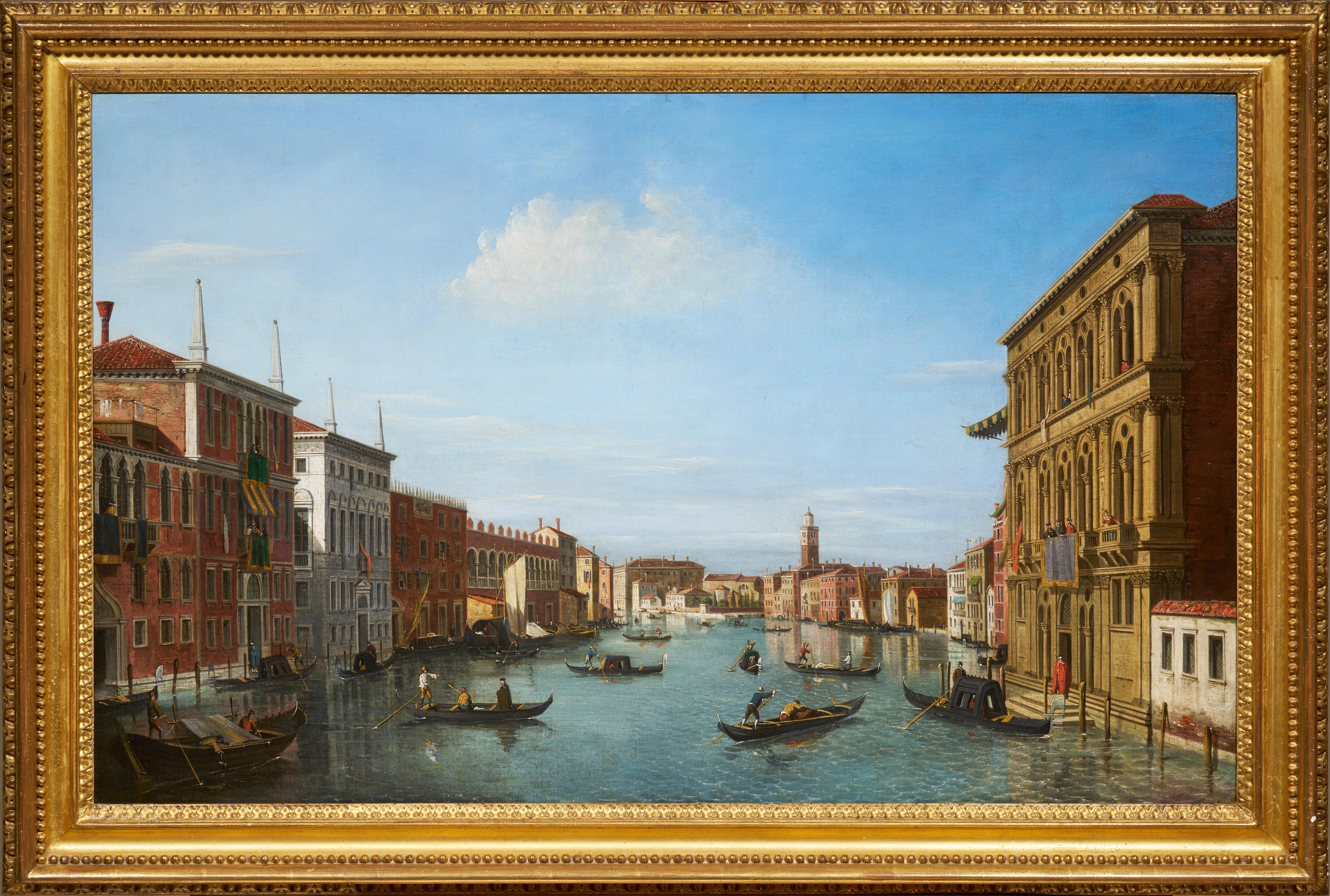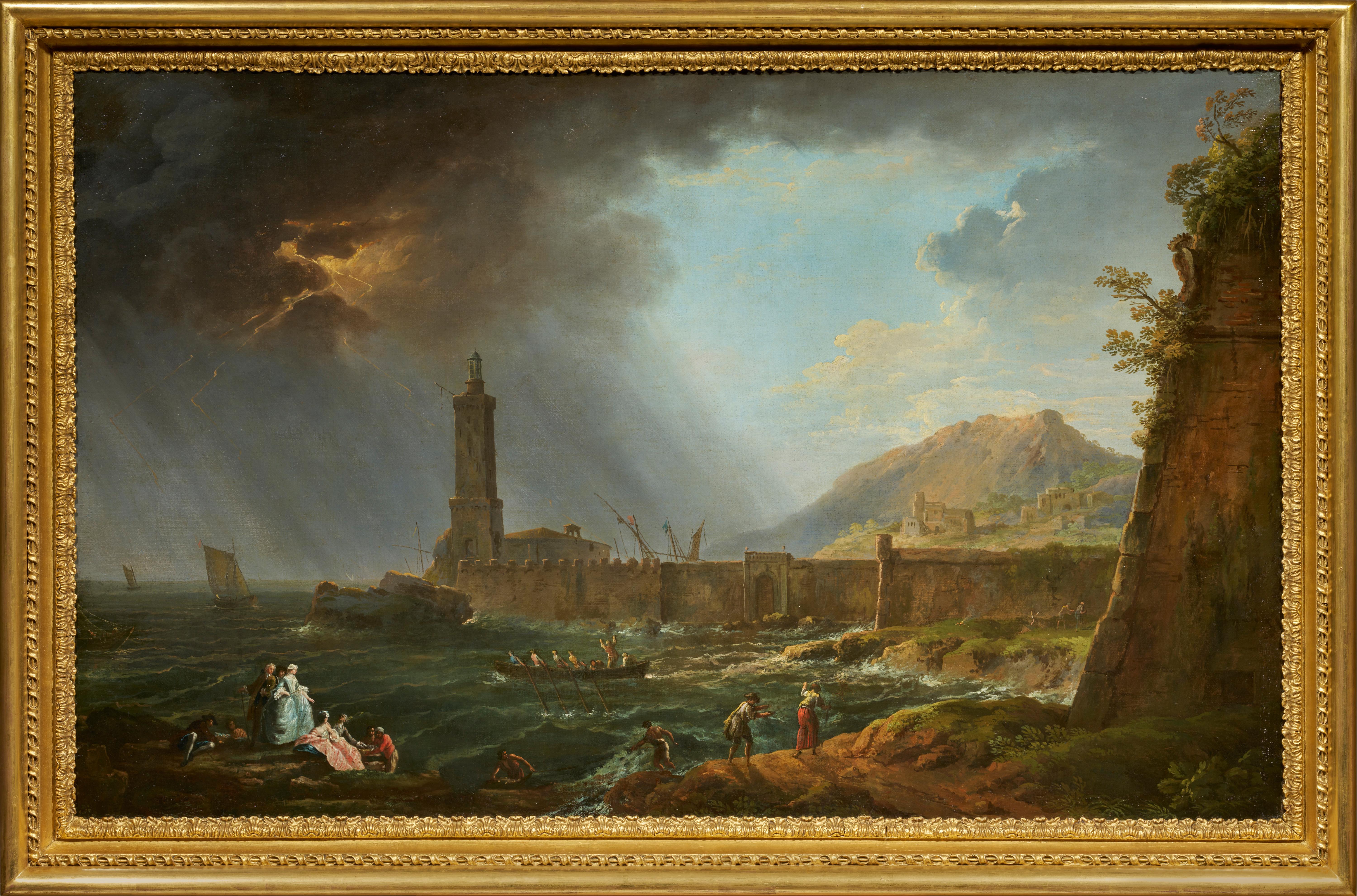Items Similar to A Ray of Sunlight
Want more images or videos?
Request additional images or videos from the seller
1 of 11
UnknownA Ray of SunlightCirca 1800
Circa 1800
About the Item
Ruisdael is regarded as the principal figure among Dutch landscape painters of the second half of the 17th century. His naturalistic compositions and style representing massive forms and his color range constituted a new direction towards a stricter sense of unity and simplification in landscape painting. The paint is broadly applied over wide areas, the gradations of color flowing into one another. Man is seemingly insignificant in comparison to the grandeur of nature. This work was painted in homage by a follower of Ruisdael during the first half of the 19th century while Ruisdael’s work was enjoying great popularity during the Romantic Age. The original hangs in the Louvre, and was acquired by Louis XVI in 1784.
- Creation Year:Circa 1800
- Dimensions:Height: 32 in (81.28 cm)Width: 39 in (99.06 cm)
- Medium:
- Movement & Style:
- Period:
- Condition:
- Gallery Location:Atlanta, GA
- Reference Number:1stDibs: LU1552397642
About the Seller
5.0
Vetted Seller
These experienced sellers undergo a comprehensive evaluation by our team of in-house experts.
Established in 2003
1stDibs seller since 2015
115 sales on 1stDibs
Typical response time: 10 hours
- ShippingRetrieving quote...Ships From: Atlanta, GA
- Return PolicyA return for this item may be initiated within 7 days of delivery.
More From This SellerView All
- Mountain Landscape with Animals and FiguresLocated in Atlanta, GAA student of Regnault and of Bertin, Jean-Charles Joseph Rémond exhibited at the Salon from 1814 to 1848. He was awarded his first grand prize in 1821 for "L'enlevement de Proserpi...Category
19th Century Academic Landscape Paintings
MaterialsOil, Canvas
- "Acolyte" - surreal floral painting - clouds - Rene MagritteLocated in Atlanta, GA"Acolyte" is a large scale oil painting featuring hues of bright orange, blue and grey. Jim Wise is inspired by the works of Georgia O'Keeffe, Rene Magritte, ...Category
2010s Surrealist Abstract Paintings
MaterialsCanvas, Oil
- "Charlie's House" - large scale shell painting - beach - Georgia O'KeeffeLocated in Atlanta, GA"Charlie's House" is a large scale oil painting featuring hues of orange, tan, pink and yellow. Jim Wise is inspired by the works of Georgia O'Keeffe, Rene Ma...Category
2010s Realist Landscape Paintings
MaterialsCanvas, Oil
- Pasture with CowsBy Rémy CoggheLocated in Atlanta, GABorn in Mouscron in the Belgian province of Hainaut, Cogghe attended the Academy of Roubaix where he studied under Constantin Mils. In 1876, Cogghe was admitted to the École Nation...Category
Early 1900s Academic Landscape Paintings
MaterialsCanvas, Oil
- Field with Two FarmersBy Carl Peter BurnitzLocated in Atlanta, GABorn in Frankfurt, Burnitz graduated from the University of Berlin in 1847 as a lawyer. After graduation, Burnitz traveled and painted for five years in Italy. Abandoning his law career, Burnitz traveled to Paris where he was introduced to the ideas of the Barbizon School by lithographer Karl Bodner. Studying under Emile Lambinet...Category
19th Century Impressionist Landscape Paintings
MaterialsCanvas, Oil
- "Content" - Contemporary Aerial Landscape Paintings - Hilma af KlintBy Kate Hooray OsmondLocated in Atlanta, GA"Content" is a large scale aerial landscape featuring rich hues of magenta, blue, purple, and gold. Kate Hooray Osmond is an American painter and installation artist based Charleston, SC. She is best known for her large-scale paintings with bold colors and gold leaf overlay. Her paintings are inspired by source images she takes from helicopters. One of Osmond's favorite things about viewing a city from above is the juxtaposition of the natural and the man-made, often sitting back-to-back with one another. She was named the State Fellow for South Carolina by the SouthArts Commission 2018 and Lowcountry Artist of the Year 2017. Kate is an MFA candidate at Maryland Institute College of Art. She exhibits internationally and her work is found in private collections as well as public, notably the College of Charleston and HBO Productions. Kate Hooray Osmond is inspired by the work of Hilma af Klint...Category
2010s Contemporary Landscape Paintings
MaterialsGold Leaf
You May Also Like
- Early oil depicting the Great Fire of LondonLocated in London, GBThe Great Fire of London in September 1666 was one of the greatest disasters in the city’s history. The City, with its wooden houses crowded together in narrow streets, was a natural fire risk, and predictions that London would burn down became a shocking reality. The fire began in a bakery in Pudding Lane, an area near the Thames teeming with warehouses and shops full of flammable materials, such as timber, oil, coal, pitch and turpentine. Inevitably the fire spread rapidly from this area into the City. Our painting depicts the impact of the fire on those who were caught in it and creates a very dramatic impression of what the fire was like. Closer inspection reveals a scene of chaos and panic with people running out of the gates. It shows Cripplegate in the north of the City, with St Giles without Cripplegate to its left, in flames (on the site of the present day Barbican). The painting probably represents the fire on the night of Tuesday 4 September, when four-fifths of the City was burning at once, including St Paul's Cathedral. Old St Paul’s can be seen to the right of the canvas, the medieval church with its thick stone walls, was considered a place of safety, but the building was covered in wooden scaffolding as it was in the midst of being restored by the then little known architect, Christopher Wren and caught fire. Our painting seems to depict a specific moment on the Tuesday night when the lead on St Paul’s caught fire and, as the diarist John Evelyn described: ‘the stones of Paul’s flew like grenades, the melting lead running down the streets in a stream and the very pavements glowing with the firey redness, so as no horse, nor man, was able to tread on them.’ Although the loss of life was minimal, some accounts record only sixteen perished, the magnitude of the property loss was shocking – some four hundred and thirty acres, about eighty per cent of the City proper was destroyed, including over thirteen thousand houses, eighty-nine churches, and fifty-two Guild Halls. Thousands were homeless and financially ruined. The Great Fire, and the subsequent fire of 1676, which destroyed over six hundred houses south of the Thames, changed the appearance of London forever. The one constructive outcome of the Great Fire was that the plague, which had devastated the population of London since 1665, diminished greatly, due to the mass death of the plague-carrying rats in the blaze. The fire was widely reported in eyewitness accounts, newspapers, letters and diaries. Samuel Pepys recorded climbing the steeple of Barking Church from which he viewed the destroyed City: ‘the saddest sight of desolation that I ever saw.’ There was an official enquiry into the causes of the fire, petitions to the King and Lord Mayor to rebuild, new legislation and building Acts. Naturally, the fire became a dramatic and extremely popular subject for painters and engravers. A group of works relatively closely related to the present picture have been traditionally ascribed to Jan Griffier...Category
17th Century Old Masters Landscape Paintings
MaterialsOil, Canvas
- View of the Grand Canal, a painting by William James, after CanalettoBy William JamesLocated in PARIS, FRAlthough we have little bibliographical information on William James, we know that he was trained by Canaletto during the painter's stay in England between 1746 and 1755. Although he may never have been to Venice, William James remained under the influence of his master for a long time and became known for his paintings inspired by Canaletto's artworks. In this painting, William James is inspired by one of the twelve views of the Grand Canal painted by Canaletto for Joseph Smith, or more precisely by the engraving made by Antonio Visentini in 1735 after this painting. He delivers a very personal version, vibrant with colours, in which he brilliantly reproduces the moving surface of the sea, animated by the ever-changing traffic of the gondolas. 1. William James, the English follower...Category
Mid-18th Century Old Masters Landscape Paintings
MaterialsCanvas, Oil
- The Arrival of the Storm, a painting by the school of Claude-Joseph VernetBy Claude-Joseph VernetLocated in PARIS, FRDuring his stay in Italy from 1734 to 1752, Joseph Vernet made several trips to Naples between 1737 and 1746, where he painted numerous maritime scenes. The pre...Category
1770s Old Masters Landscape Paintings
MaterialsCanvas, Oil
- The Parade of Swiss Guards a painting on canvas by Gabriel de Saint-AubinLocated in PARIS, FRIn this painting, Gabriel de Saint-Aubin, the great chronicler of the reign of Louis XV, takes us to the annual parade of the Swiss Guards at the Plaine de...Category
1760s Old Masters Figurative Paintings
MaterialsCanvas, Oil
- 18th Century By Vincenzo Re The Pool of Bethesda Oil on CanvasLocated in Milano, LombardiaExpertise by Prof. Giancarlo Sestieri. Vincenzo Re (Parma, 1695 – Napoli?, 1762) born in Parma, was an Italian scenic designer who during his career worked as initially an assistant...Category
18th Century Old Masters Landscape Paintings
MaterialsCanvas, Oil
- 17th Century by Simone Cantarini Adoration of The Magi Painting Oil on CanvasLocated in Milano, LombardiaSimone Cantarini (Pesaro 1612 - Verona 1648) Adoration of the Magi Oil on paper applied to canvas, cm. 16,5 x 24 – with frame cm. 22 x 29 Antique sh...Category
Early 17th Century Old Masters Figurative Paintings
MaterialsCanvas, Cotton Canvas, Oil
Recently Viewed
View AllMore Ways To Browse
Paintings Of The Xvi Century
17th Century Dutch Landscape
17th Century Dutch Landscape Paintings
Oil Xvi
Man Ray Original
Landscape Oil Painting 1800
Old Man Oil Painting 19th Century
Dutch Louis Xvi
Antique Landscape Oil Painting Impressionist
Romantic Landscape Large
Pennsylvania Impressionist Oil
New York City Harbor
Farm Scene Paintings
Dame Vintage
French Impressionist Painting Gold Frame
Tonal Landscape
County Fair
Tonalism Landscape





